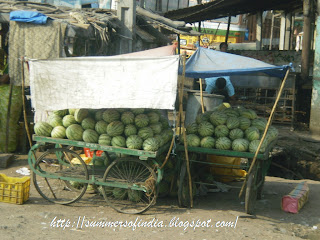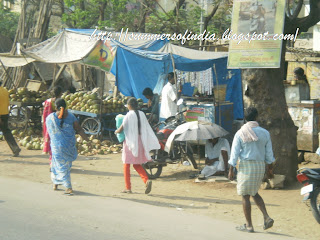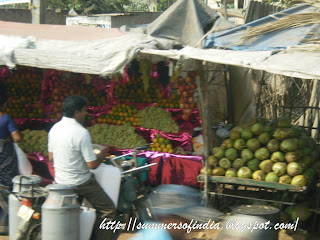Hi! I just wanted to share some of my moments when I recently visited the temple of Lord Venkateshwara in Tirupathi.
ABOUT THE TEMPLE
Tirupathi is the most famous temple town situated in Chittoor District in the State of Andhra Pradesh. The main deity here is Lord Venkateswara.
The chain of Seven Hills known as
Saptha(seven)
Giris(hills) consisits of
Seshadri, Neeladri, Garudari, Anjanadri, Vrishbhadri, Narayanadri and
Venkatadri. These are together known as
Tirumala. The Lords temple is on the seventh hill-
Venkatadri or
Venkatachalam at an altitude of 840m (2,800 ft). That is why HE is also know as
Venkatachalapathi, Edukonadalawada and
Saptha Girishwara-meaning Lord of Seven Hills
.
It is believed in Hindu Mythology that Lord Vishnu one of the Holy Trinities of-
Brahma(The Creator),
Vishnu( The Preserver ) and
Shiva ( The Destroyer), has come down to earth in person (later turned into a stone or statue) to reside at this place for the entire period known as Kali Yuga. So by visiting HIM in the temple is visiting Lord Vishnu himself.
The exact origin or beginnings of the temple is not known. Some point out that this temple was referred to in the ancient
Rigveda. It is a fact that by 5th century AD it was a well established center. But during the rule of the
Vijayanagara Emperors this temple was improved and the rulers donated lots of gold, jewels lands and huge donations especially by the famous Emperor
Sri Krishnadevaraya.
The temple itself was renovated and constructed by the
Vijayanagara Rulers. Many other rulers like the
Marathas and from Mysore and Gadwal also made donations and other offerings to the temple.
In 1843, with the coming of the East India Company, the administration of the Sri Venkateswara temple and a number of shrines was entrusted to Seva Dassji of the
Hathiramji Mutt at Tirumala as
Vicaranakarta for nearly a century until 1932, when Tirumala Tirupathi Devasthanams (TTD) as per the TTDAct 1932 was established.
The temple is the richest and the most visited place of worship in the world. The temple is visited by large number of piligrims.
OFFERINGS
One of the peculiar offerings made here to Lord by the devotees is offering their hair by tonsuring their heads. Especially in Hindus the tonsuring of hair of a male( even female) child within one year or in the third year is an important ceremony. Its considered as auspicious to get the first tonsure done here. Its a tradition observed in most South Indian families.Till then the hair of the child is not removed at all.
Many devotees have their head tonsured as an offer. When one is in difficulties or desires something, they promise the Lord that on fulfillment of their desires they will offer their hair to Him.The daily amount of hair collected is over a ton. The hair thus gathered is sold in public auction periodically to national and international buyers for use in wigs and other such cosmetic purposes, bringing over six million dollars to the temple's treasury.
Apart from this, devotees offer cash, gold, silver, jewels, gems according to their wishes.They put this into a box known as Hundi .The average income is around Rs 10 lakh per day and annual income is considered to be around 125 million dollars.
Koluvu Srinivasa is brought daily in the morning and seated on a silver chair. He is the guardian Deity who is believed to supervise the temple affairs. The calendar of the day (Panchangam) and the accounts of the temple are read to him every day.
Pilgrims can also participate in various paid
Sevas (various types of prayers or ritualsor offerings). All this money earned from the temple is used for supporting, various social, religious and charitable institutions across the country including University for Women, educational institutions, hospitals, institutions offering religious studies and upkeep of various ancient temples across India.
Since it is second only to Vatican in its earnings, the temple is also known as
"Vatican of the East".
PRASADAM
Laddu Prasadam -that is a sweet dish offered to the Lord here is world famous Many other Prasadams are like
Dhadhojanam (curd rice),
Pulihora (tamarind rice),
Vada, Pongali and
Chakkera pongali(sweet) are also offered and are available to the devotees. Free meals are provided daily to the pilgrims.
One can either reach the temple at Tirumala by walk from Tirupathi or by cars or buses. However, I love to go by walk, along with friends and family. Its a route of 16Km and has 4000 steps, surrounded by beautiful jungles. Most of the route is covered by overhead shelters protecting the pilgrims from sun and rain. It takes around two to four hours to climb the hills. En route there are stalls offering refreshments. Its advisable to start early in the morning say 4 am to avoid the heat. Its an experience to go by this route by foot surrounded by the nature and chanting the name of the Lord. We come across people from various walks of lives. Newly married couples often visit this shrine in their wedding costumes. Many marriages are also held here in the premises of the Lord and it is considered to be auspicious to do so.
Groups of families, friends, youngsters, children, senior citizens from various cultures, speaking different languages can be found happily climbing the path. The most striking aspect I find is the rural folk with immense belief in the Lord, who come here in huge groups from all over India and climb the path singing and chanting in praise of the Lord.
This time though we went by car since my mom cannot walk all the way.
This is at the base of the seven hills in Tirupathi, from where we start our ascent to Tirumala by vehicles, after checking of our vehicles. Such beautiful and majestic mountains of the Lord. This is the route taken by the vehicles. there is a separate route for those who go by foot.

This is en route; a view of the mountains before us.

Both the routes up and down are with hair pin bends and with many curves. One may feel nauseous while climbing up or coming down so may have to go very slowly sometimes stopping in between. But the views from there are breath taking.

This is the building where the name of the Lord is chanted continuously. We had to stop here while my brother was getting his head tonsured as an offering to the Lord.Besides this is the place where free meals is served to the pilgrims.

Wind mills on the mountains. Harvesting the wind power.


On the way to the Lords Temple. These are shopping complexes, where one can buy bangles, vermilion, turmeric, statues and photos of various deities and various items made of copper and brass used in our daily rituals by Hindus, like oil lamps, bells etc, toys and dolls for children both traditional and modern, utensils used in a kitchen and many more. These are a regular feature near every temple in India.
There is a tank next to the temple called
Swami Pushkarini.
The
Vimana (dome), known as
Ananda Nilayam (Abode of happiness), is above the Deity's main room. It is covered in solid gold. The
Dwajasthamba (flag-pole ) is gold-plated, and the gates that guard the inner sanctum are also covered with gold. The entire visit inside the temple creates an awesome feeling as it is gold plated with intricate carvings. reflecting the lights from the crystal chandeliers. The pilgrims who reach inside forget everything and chant Lords names- Govinda, Govinda. They are just eager to have a glimpse of the Lord.

This is
Lord Vekateshwara or
Balaji
It is believed that Lord Venkateswara, is a
Swayambhu (self-manifested), 2m (around 6 ft) high Deity made of a jet-black stone and is in a standing pose, standing on a lotus. His two upper arms hold a conch-shell (
Shankha) and disk (
Chakra).














































